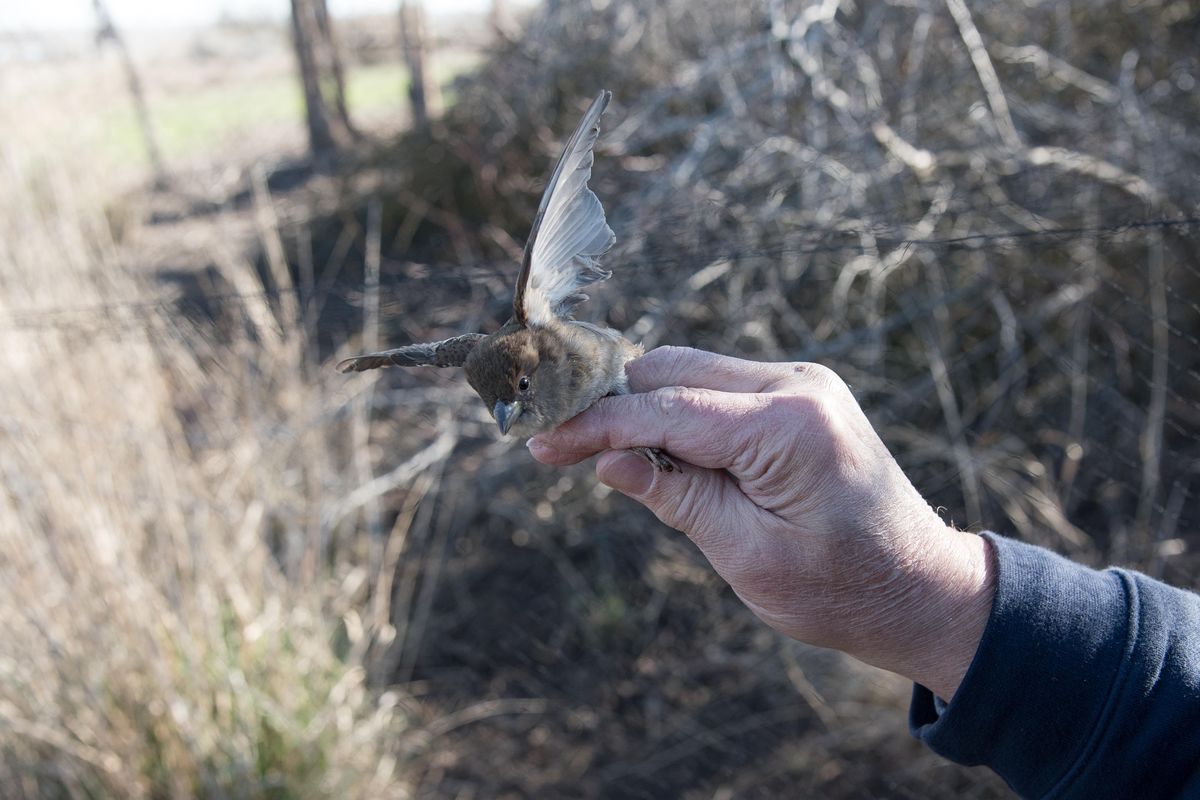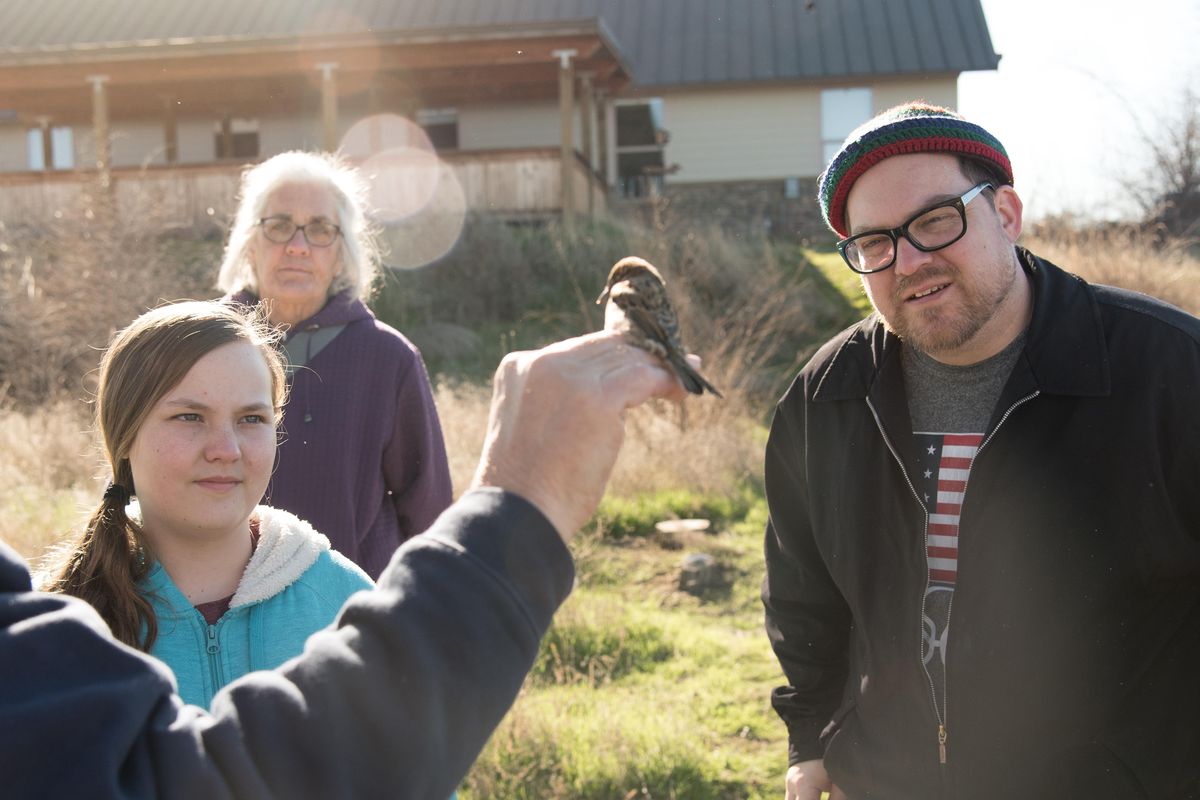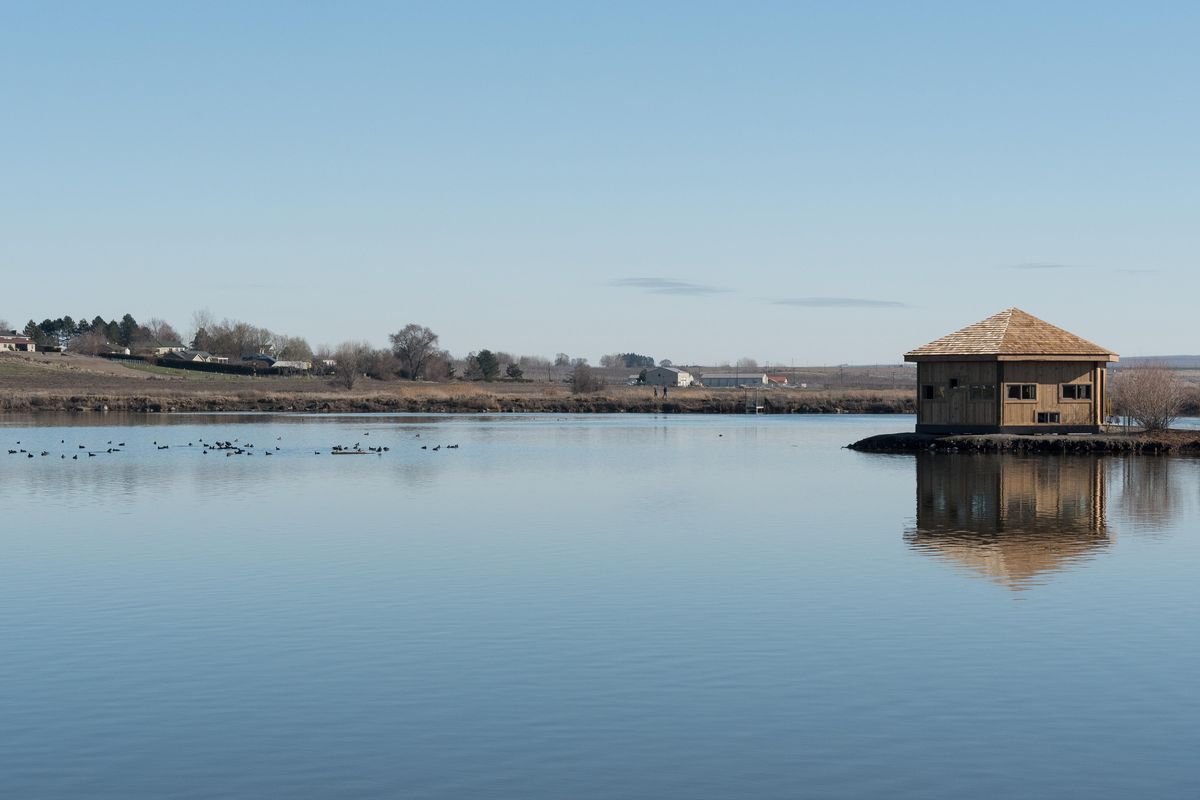Dreaming of flight: The big business of birding
Chris Baugh, right, Haven Baugh and Frances Peterson watch a member of the Lower Columbia Basin Audubon Society hold up a common house sparrow caught on Saturday, Feb. 10, 2018. (Eli Francovich / The Spokesman-Review)Buy a print of this photo
PASCO – In a land of big-rigs, farm combines, freeway interchanges and long-haul trucking, the people came dreaming of flight.
They gazed upward, through binoculars, squinting into Saturday’s winter sunlight. All trying to catch sight of migrating winter birds.
The birds, for their part, paid little, if any, attention to the land-locked gazes.
“The thing is that humans have been fascinated by flight forever,” said Ed Rykiel, a retired ecologist and an avid birder in the Tri-Cities area.
Airplane wings are modeled after birds. Birds, and dreams of flight, feature prominently in myth, art, poetry and literature.
People flocked to the McNary National Wildlife Refuge on Saturday to see, and learn about, our airborne muses.
Rykiel was volunteering with the Lower Columbia Basin Audubon Society. The morning kicked off with the opening of a new bird blind. Refuge staff and Audubon volunteers gave talks and demonstrations.
In addition to any latent longing for flight, birding is a big business. In 2016, more than 45 million people watched birds according to the National Survey of Fishing, Hunting and Wildlife-Associated Recreation.
Those birders spent nearly $41 billion annually on trips and equipment, according to a 2011 survey. Of that, birders spent $14.9 billion in local communities on food, lodging and transportation. That influx created an estimated 666,000 jobs.
A more recent U.S. Fish and Wildlife Service study estimated that nationwide wildlife watchers spent about $75.9 billion in 2016. Of the estimated 86 million wildlife watchers, more than half were bird watchers.
“It’s a big economic factor,” said Lindell Haggin, an active member in the Spokane Audubon Society.
In Washington, 24 percent of residents went birding, according to the 2011 survey. In Idaho, it was 29 percent. Meanwhile, 19 percent of Idaho’s birders came from out of state, while 17 percent of Washington’s birding participants were non-residents.
Avid bird watchers will travel across the country and world to see a rare bird. Last year a red-flanked bluetail, a Siberian bird that normally winters in Asia, made an appearance in Lewiston. That drew people from all around the nation.
“If there is a rare bird sighting somewhere, people are like, ‘I’ve got to see that,’ ” said Gail Gatton the executive director of Audubon Washington. “They don’t hesitate to take a vacation day and make the trip to see that bird.”
Bird watching festivals can also bring in money. Hotels in Othello, Washington, book months in advance in preparation for the annual three-day Othello Sandhill Crane Festival in March.
Part of the allure of birdwatching, Rykiel said, is that it’s an accessible and interesting hobby.
“Of all the wildlife you could see, birds are the most obvious,” he said. “You’re more likely to see a bird than a wolf.”
While there is a certain stereotype associated with bird watching – aging retirees – it hasn’t always been that way, said Haggin.
“What’s interesting, is well in the 1970s you had this big environmental push,” she said. “So some of the same people who are on the Audubon board in 1970 are still on the same board, 47 years later.
“One of the frustrations, for lots of chapters … is getting more of the younger generations involved.”
Beyond the intrinsic interest and joy many find in bird watching, there is another, more important reason to keep the pastime alive. Birders and bird watching associations are a powerful advocate for conservation. Haggin worries about what will happen if a younger generation doesn’t pick up the reigns.
The Audubon Society was founded in 1905 in memory of John James Audubon, a naturalist and artist who documented birds in America. Over the years, the society has increasingly turned its energy toward habitat conservation and protection, lobbying on behalf of major environmental policies.
The society has more than 600,000 members and 500 chapters in the United States. In Washington there are 25 Audubon chapters and 35,000 members.
And while some chapters might struggle with attracting new members, overall bird watching participation has increased both locally and nationally, Gatton said. Increasingly, bird watching associations, like Audubon, are trying to make the pastime accessible to the general public – whether by providing binoculars, not starting early in the morning or serving coffee.
Introducing people to bird watching was part of the focus on Saturday at McNary National Wildlife Refuge. Audubon members demonstrated bird banding – the process of putting a small metallic ring on a bird’s leg. Traditionally those rings were used to track migration paths. Now, the bands are used to study the diet and health of bird populations.
Nicki Cramer brought her two grandchildren, Lucy Cramer, 6, and Isaac Cramer, 4, to the refuge. She hopes to instill an appreciation for nature in the children – and birds seemed like an easy way to do so.
“It’s just because it’s such a huge part of the environment,” she said. “I mean, everybody has access to birds.”
Curtis Mahon, 17, is the youngest member of the Spokane Audubon Society. The high school senior started birding in 2016 after watching “The Big Year,” a bird-watching comedy featuring Jack Black, Owen Wilson and Steve Martin.
Since then he’s devoted as much time as possible to the activity. He loves seeing new birds and watching their everyday, often surprising, behaviors.
In fact, Mahon is enrolled in an online school which allows him to “stop my school right then to go see a rare bird and then come back and do school.”
“Whenever I’m outdoors I have my camera,” he said. “And whenever I have my camera I’m birding.”
And, Mahon’s dad is a pilot – a fact he didn’t connect to his passion for birding until asked.
“Thinking about it now, I’m very much into flight,” he said. “It does seem to be part of it.”





